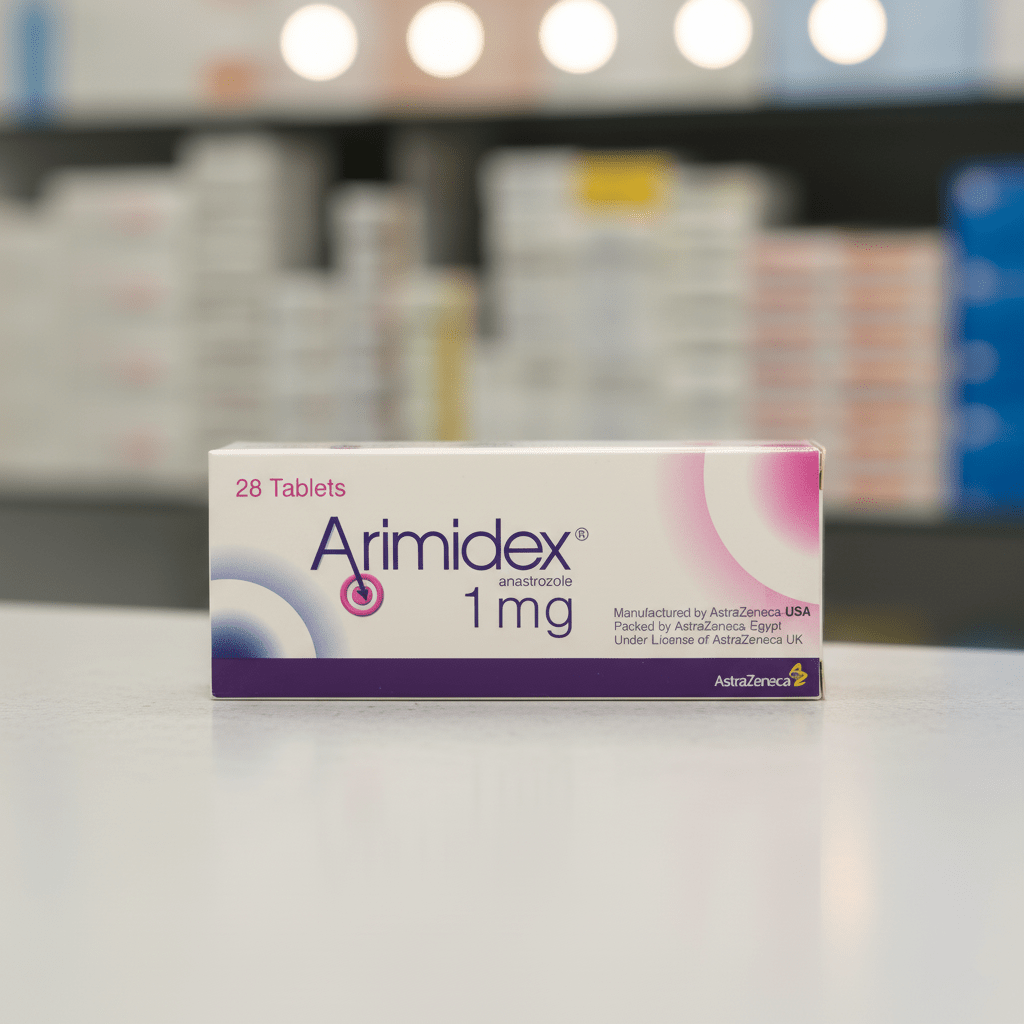Arimidex (Anastrozole) 1 mg: Essential Guide to Use, Dosage, and Estrogen Control

Arimidex, generically known as Anastrozole, is a highly effective aromatase inhibitor used to manage estrogen levels in various medical and therapeutic contexts. Whether you’re navigating breast cancer treatment or managing hormonal imbalances, Arimidex 1 mg plays a pivotal role in estrogen control. This comprehensive, SEO-optimized guide dives deep into its uses, dosage guidelines, benefits, potential side effects, and practical considerations to provide a thorough resource for patients, caregivers, and those seeking to understand this medication.
Understanding Arimidex (Anastrozole)
Arimidex contains Anastrozole, a non-steroidal aromatase inhibitor that reduces estrogen production by blocking the aromatase enzyme. This enzyme converts androgens (male hormones) into estrogens (female hormones), and by inhibiting this process, Arimidex effectively lowers circulating estrogen levels. This mechanism is critical for conditions where excess estrogen contributes to health issues.
Primary Uses of Arimidex 1 mg
Arimidex is prescribed for a range of conditions, summarized in the table below:
| Condition | Primary Use |
|---|---|
| Breast Cancer (Postmenopausal) | Treats hormone receptor-positive breast cancer to prevent recurrence. |
| Estrogen Control in Men | Manages elevated estrogen levels during testosterone replacement therapy (TRT) or anabolic steroid use. |
| Hormonal Imbalance | Regulates estrogen in conditions like estrogen dominance under medical supervision. |
Breast Cancer Treatment
Arimidex is FDA-approved for postmenopausal women with hormone receptor-positive breast cancer. By reducing estrogen, it starves cancer cells that rely on estrogen to grow, making it a cornerstone of adjuvant therapy. It’s often used after surgery to lower the risk of cancer recurrence or in advanced cases to slow disease progression.
Estrogen Management in Men
For men on TRT or using anabolic steroids, excess testosterone can convert to estrogen via aromatization, leading to side effects like gynecomastia (breast tissue growth), water retention, or mood swings. Arimidex helps maintain a balanced testosterone-to-estrogen ratio, enhancing treatment outcomes.
Hormonal Imbalance
In rare cases, Arimidex is used off-label to manage conditions like estrogen dominance or polycystic ovary syndrome (PCOS) in women, though this requires careful medical oversight due to its potency.
How Arimidex Works
Anastrozole targets the aromatase enzyme, which is found in tissues like fat, muscle, and the adrenal glands. By inhibiting aromatase, Arimidex reduces estrogen production, which is particularly beneficial for:
- Postmenopausal Women: Since their ovaries no longer produce estrogen, Arimidex targets peripheral estrogen synthesis.
- Men: Prevents testosterone from converting to estradiol (a form of estrogen), maintaining hormonal balance.
This targeted action makes Arimidex highly effective, but it requires precise dosing to avoid over-suppressing estrogen, which is essential for bone health, mood, and overall well-being.
Dosage Guidelines for Arimidex 1 mg
The dosage of Arimidex depends on the condition being treated and individual factors like hormone levels and medical history. Below is a detailed dosage table:
| Condition | Standard Dosage | Frequency | Duration | Notes |
|---|---|---|---|---|
| Breast Cancer (Postmenopausal) | 1 mg | Daily | 5 years or longer | Part of adjuvant therapy; follow oncologist’s guidance. |
| Estrogen Control (Men on TRT) | 0.25–1 mg | Every other day or 2–3 times weekly | As needed based on bloodwork | Adjust based on estradiol levels (20–30 pg/mL ideal). |
| Hormonal Imbalance (Off-Label) | 0.5–1 mg | As prescribed | Varies based on condition | Requires close medical supervision. |
Administration Tips
- Consistency: Take Arimidex at the same time daily, with or without food, to maintain stable blood levels.
- Missed Dose: If you miss a dose, take it as soon as remembered unless it’s within a few hours of the next dose. Never double up.
- Bloodwork: For men, regular monitoring of estradiol, testosterone, and other markers is critical to optimize dosing and avoid side effects.
- Splitting Doses: In men, lower doses (e.g., 0.5 mg) can be achieved by splitting 1 mg tablets, but consult a pharmacist for accuracy.
Special Considerations
- Women: Arimidex is not typically used in premenopausal women unless ovaries are non-functional (e.g., post-chemotherapy).
- Men: Over-suppression of estrogen can lead to low libido, joint pain, or fatigue, so precise dosing is essential.
- Medical Oversight: Always follow a healthcare provider’s instructions and avoid self-medicating.
Benefits of Arimidex for Estrogen Control
Arimidex offers numerous benefits, making it a preferred choice for estrogen management:
| Benefit | Description |
|---|---|
| Targeted Estrogen Reduction | Effectively lowers estrogen to manage breast cancer or prevent gynecomastia. |
| Hormonal Optimization | Supports balanced testosterone-to-estrogen ratios, improving TRT outcomes. |
| Long-Term Safety | Well-tolerated with a proven track record in long-term use (e.g., 5+ years for cancer). |
| Flexible Dosing | Adjustable for men based on bloodwork, allowing personalized treatment. |
| Easy Administration | 1 mg tablets are convenient and integrate seamlessly into daily routines. |
Additional Advantages
- Prevents Side Effects: In men, reduces risks of gynecomastia, bloating, and emotional instability caused by high estrogen.
- Supports Cancer Management: Improves survival rates in hormone receptor-positive breast cancer when used as prescribed.
- Versatility: Applicable in both medical (cancer) and therapeutic (TRT) contexts.
Potential Side Effects and Management
While Arimidex is generally well-tolerated, it can cause side effects, particularly with long-term use or improper dosing. Below is a comprehensive table:
| Side Effect | Frequency | Symptoms | Management Strategies |
|---|---|---|---|
| Hot Flashes | Common | Sudden warmth, sweating | Stay hydrated, wear breathable clothing. |
| Joint Pain/Stiffness | Common | Aches in joints or muscles | Consider glucosamine, physical therapy, or NSAIDs. |
| Fatigue | Common | Tiredness or low energy | Prioritize rest, balanced diet, and light exercise. |
| Bone Density Loss | Less Common | Risk of osteoporosis with long-term use | Monitor bone density; use calcium/vitamin D supplements. |
| Mood Changes | Less Common | Irritability, depression | Discuss with a doctor; consider counseling. |
| Nausea or Headache | Less Common | Mild digestive upset or headaches | Take with food; stay hydrated. |
| Severe Allergic Reactions | Rare | Rash, swelling, difficulty breathing | Seek immediate medical attention. |
| Cardiovascular Issues | Rare | Chest pain, irregular heartbeat | Contact a doctor immediately. |
Minimizing Side Effects
- Bone Health: Long-term users, especially women, should monitor bone density and consider supplements like calcium (1,200 mg daily) and vitamin D (800–1,000 IU daily).
- Hormone Monitoring: Men should aim for estradiol levels of 20–30 pg/mL to balance benefits and risks.
- Lifestyle Support: A healthy diet, regular exercise, and stress management can mitigate side effects like fatigue and mood changes.
- Medical Follow-Up: Regular check-ups with blood tests ensure safe and effective use.
Who Should Use Arimidex?
Arimidex is appropriate for:
- Postmenopausal Women with hormone receptor-positive early or advanced breast cancer.
- Men on TRT or anabolic steroids to control estrogen-related side effects.
- Individuals with medically diagnosed estrogen imbalances (e.g., estrogen dominance, certain infertility cases).
Contraindications
- Not for Premenopausal Women: Unless ovaries are non-functional, as it’s less effective in this group.
- Pregnancy: Arimidex can harm a fetus; avoid during pregnancy or breastfeeding.
- Severe Organ Issues: Contraindicated in patients with severe liver or kidney dysfunction without medical approval.
Precautions and Drug Interactions
Before starting Arimidex, provide your doctor with a complete medical history and list of medications. Key considerations include:
| Precaution | Details | Action |
|---|---|---|
| Bone Health | Long-term use may reduce bone density, increasing fracture risk. | Regular bone density scans; consider supplements. |
| Liver/Kidney Function | Anastrozole is metabolized by the liver; dysfunction may affect clearance. | Monitor liver/kidney function via blood tests. |
| Drug Interactions | May interact with estrogen therapies (e.g., HRT), tamoxifen, or supplements. | Avoid concurrent use of estrogen-based drugs. |
| Allergies | Rare but possible reactions to Anastrozole or excipients. | Report any rash, swelling, or breathing issues. |
Lifestyle Tips for Users
- Diet: Focus on nutrient-rich foods (e.g., leafy greens, lean proteins) to support overall health.
- Exercise: Weight-bearing exercises (e.g., walking, resistance training) help maintain bone density.
- Hydration: Adequate water intake reduces side effects like hot flashes and headaches.
Where to Buy Arimidex in the US
Arimidex is a prescription-only medication in the United States, requiring a doctor’s prescription. To purchase safely:
- Consult a Healthcare Provider: Obtain a prescription from a licensed physician or specialist (e.g., oncologist, endocrinologist).
- Reputable Pharmacies: Buy from accredited pharmacies, either in-store or online. Look for certifications like NABP’s Verified Internet Pharmacy Practice Sites (VIPPS).
- Avoid Counterfeits: Steer clear of unverified online vendors or suspiciously cheap products, as they may be ineffective or dangerous.
- Insurance Coverage: Check with your insurance provider, as Arimidex may be covered for breast cancer treatment but less commonly for off-label uses.
Pro Tip: Online pharmacies often offer convenience, but verify their legitimacy through tools like the NABP website or state pharmacy boards.
Practical Tips for Arimidex Users
- Track Symptoms: Keep a journal of side effects or symptoms to discuss with your doctor, especially for men adjusting doses.
- Regular Bloodwork: Monitor estradiol, testosterone, and bone markers to ensure optimal dosing and safety.
- Stay Informed: Understand your condition and treatment goals to make informed decisions with your healthcare team.
- Support Systems: Join support groups for breast cancer patients or TRT users to share experiences and tips.
FAQs About Arimidex
| Question | Answer |
|---|---|
| How long does Arimidex take to work? | Estrogen levels may drop within days, but clinical effects (e.g., cancer control) may take weeks. |
| Can men use Arimidex long-term? | Yes, but only with medical oversight to prevent side effects like low estrogen. |
| Is Arimidex safe for non-cancer use? | Safe when prescribed and monitored, but recreational use is risky. |
| What if I experience side effects? | Report to your doctor; adjustments to dose or supportive therapies may help. |
Conclusion
Arimidex (Anastrozole) 1 mg is a powerful tool for estrogen control, offering significant benefits for breast cancer treatment, hormonal balance in men, and other estrogen-related conditions. Its ability to lower estrogen levels makes it invaluable, but proper dosing, medical supervision, and regular monitoring are essential to maximize benefits and minimize risks. Whether you’re managing breast cancer or optimizing TRT, Arimidex can be a game-changer when used responsibly.
For those seeking to buy Arimidex in the US, consult a licensed healthcare provider and purchase from verified pharmacies to ensure safety and efficacy. Stay proactive, informed, and engaged with your healthcare team to achieve the best outcomes with Arimidex.




